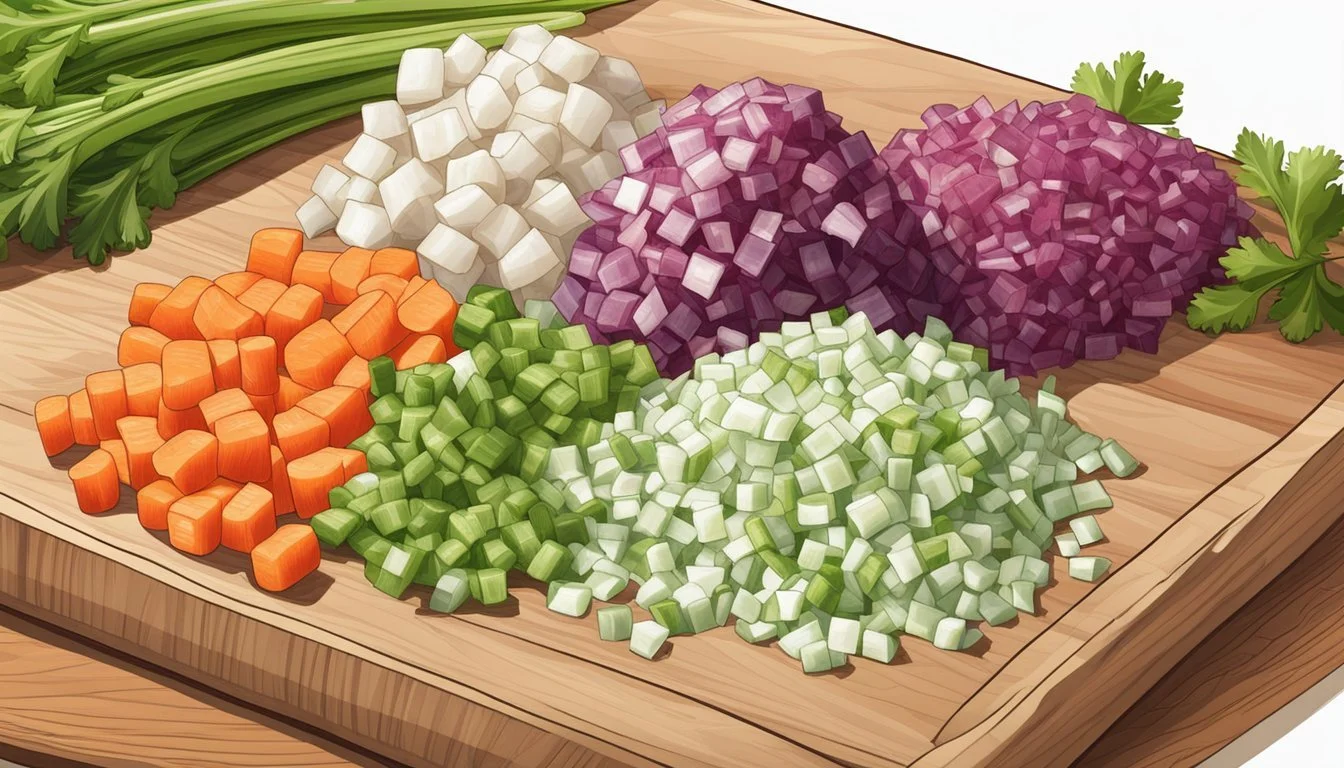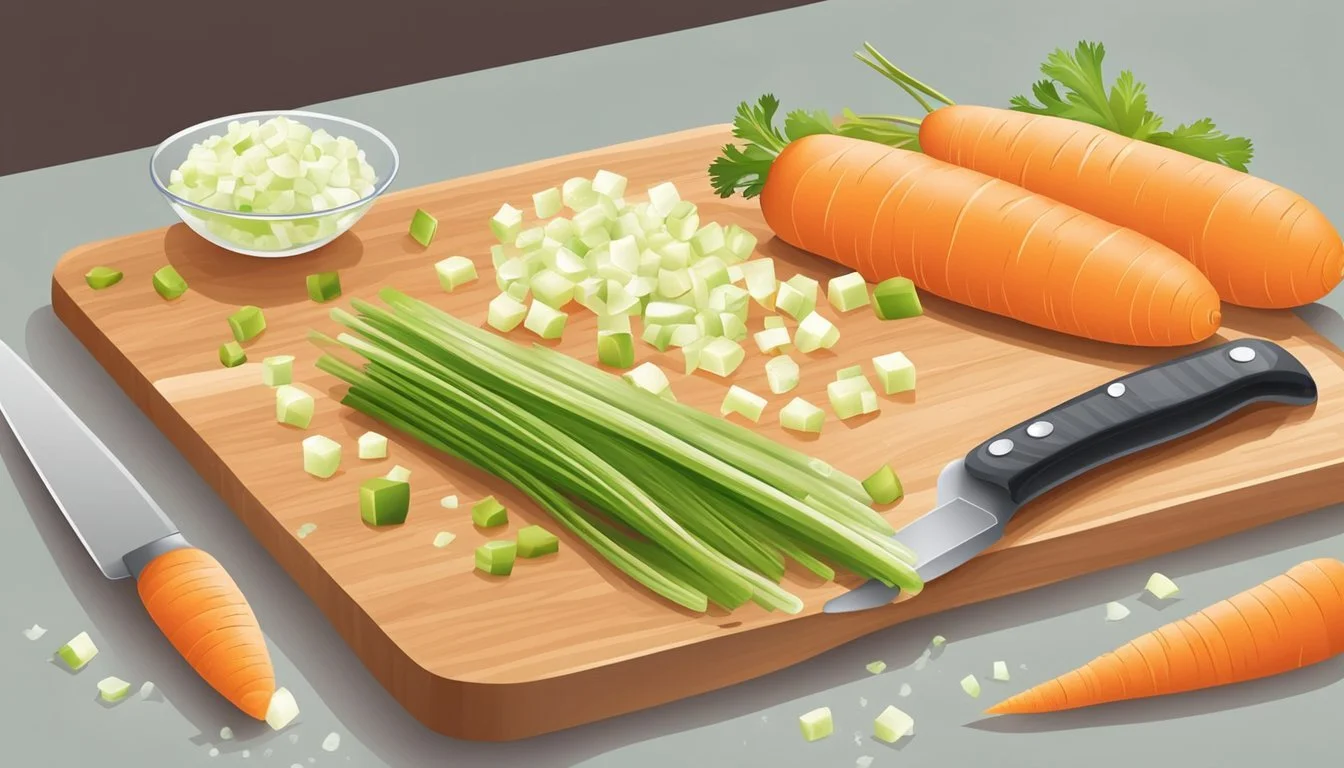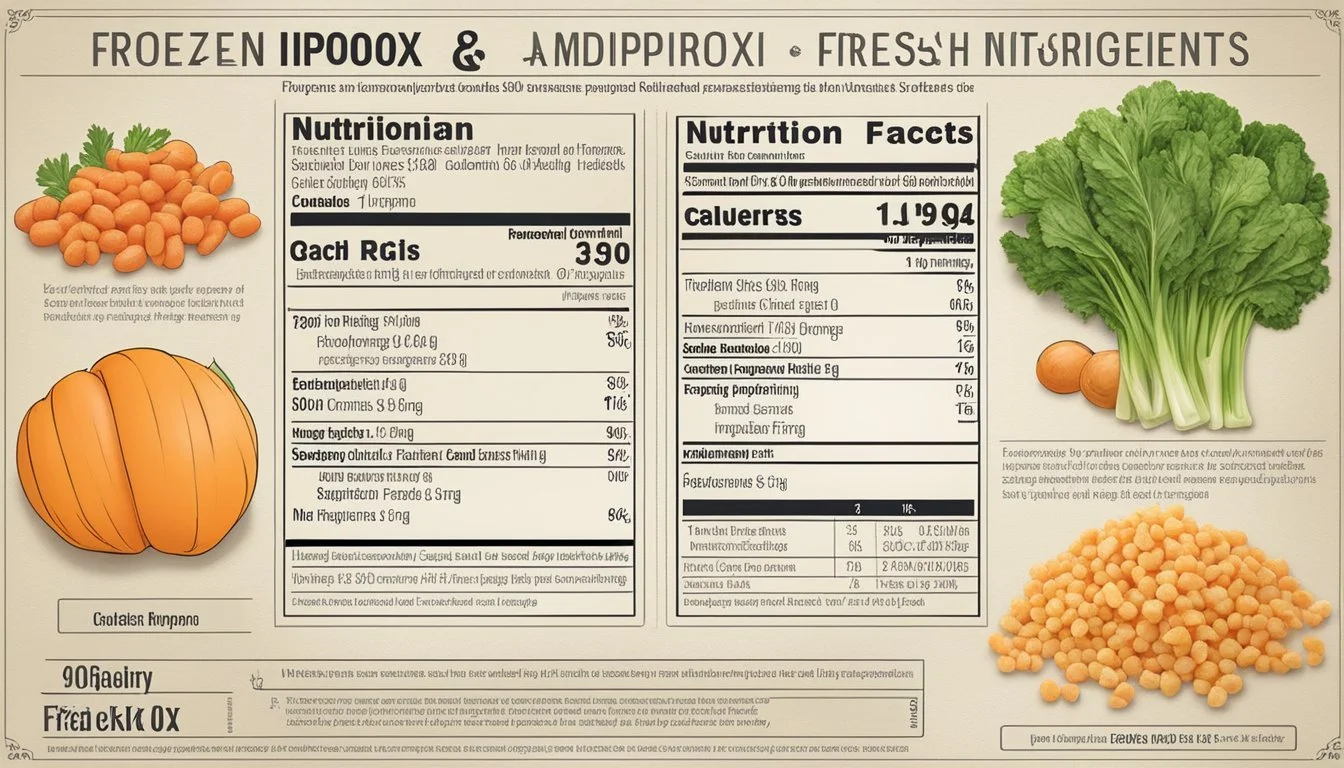Frozen vs Fresh Mirepoix: The Battle of Kitchen Convenience
Mirepoix, the aromatic blend of carrots, celery, and onions, forms the foundation of countless dishes in culinary traditions worldwide. This essential flavor base can be prepared fresh or purchased frozen, leading many home cooks to wonder about the differences between the two options.
While fresh mirepoix offers vibrant flavors and crisp textures, frozen mirepoix provides convenience and year-round availability. The choice between fresh and frozen often depends on factors like time constraints, storage space, and the specific recipe requirements. Fresh mirepoix allows for more control over the size and consistency of the vegetable cuts, which can be crucial in certain dishes.
Frozen mirepoix saves preparation time and reduces food waste, making it an attractive option for busy cooks. Some chefs argue that the freezing process can slightly alter the texture and aroma of the vegetables. However, when used in soups, stews, and sauces where the mirepoix will be cooked down, these differences become less noticeable.
Understanding Mirepoix
Mirepoix forms the aromatic foundation of many dishes in French cuisine and beyond. This versatile mixture of diced vegetables brings depth and flavor to soups, stews, stocks, and sauces.
Historical Background and Pronunciation
Mirepoix originated in 18th-century France, named after the Duke of Mirepoix. The term is pronounced "meer-pwah" in French. Initially used in aristocratic kitchens, it quickly spread throughout French cooking.
Chefs recognized mirepoix's ability to enhance flavors and add complexity to dishes. Over time, it became a fundamental technique in classical French cuisine.
Today, mirepoix is used worldwide in various cuisines, adapting to local ingredients and preferences.
Components and Ratios
Traditional French mirepoix consists of onions, carrots, and celery. The standard ratio is 2:1:1 - two parts onions to one part each of carrots and celery.
Typical mirepoix ingredients:
Onions: 50%
Carrots: 25%
Celery: 25%
Vegetables are usually diced to uniform size for even cooking. The mixture is often cooked in fat, such as butter or oil, to release flavors.
Mirepoix can be used raw, sautéed, or roasted depending on the recipe. It serves as a base for stocks, soups, and sauces.
Mirepoix Variations Worldwide
Different cultures have adapted mirepoix to suit local tastes and ingredients:
Italian soffritto: Uses onions, celery, and carrots, often with garlic and herbs.
Spanish sofrito: Incorporates tomatoes, onions, garlic, and peppers.
Cajun/Creole "Holy Trinity": Replaces carrots with green bell peppers.
German Suppengrün: Includes leeks, carrots, and celeriac.
Some variations use different ratios or add ingredients like garlic, mushrooms, or parsnips. These regional adaptations demonstrate mirepoix's versatility and global influence in cooking.
Benefits and Drawbacks of Fresh Mirepoix
Fresh mirepoix offers distinct advantages in flavor and nutrition, but requires more preparation time compared to frozen alternatives. Its impact on dishes extends beyond taste to nutritional content and cooking processes.
Optimal Flavor and Aroma
Fresh mirepoix provides superior flavor and aroma to dishes. The vegetables retain their natural oils and volatile compounds, releasing a more vibrant taste when cooked. Celery contributes a subtle earthiness, while onions add sweetness and depth. Carrots bring a mild sweetness and color to the mix.
When slowly cooked, fresh mirepoix releases its flavors gradually, creating a rich base for soups, stews, and sauces. The aroma of fresh vegetables sautéing in butter or oil can enhance the overall cooking experience.
Nutritional Considerations
Fresh mirepoix offers higher nutritional value compared to processed alternatives. Carrots provide significant amounts of vitamin A and beta-carotene. Onions contain vitamin C and antioxidants. Celery contributes vitamin K and potassium.
The vegetables in fresh mirepoix are low in calories and high in fiber. They contain minimal amounts of sodium, making them suitable for low-salt diets. Fresh mirepoix also provides small amounts of iron and calcium.
Cooking method affects nutrient retention. Gentle sautéing preserves more vitamins than prolonged boiling.
Preparation and Cook Time
Preparing fresh mirepoix requires more time and effort than using pre-cut or frozen options. Washing, peeling, and chopping vegetables can add 10-15 minutes to meal preparation.
Cooking time for fresh mirepoix varies based on the recipe:
Quick sauté: 5-7 minutes
Slow cooking for deep flavor: 10-15 minutes
Fresh vegetables may have a shorter shelf life, necessitating more frequent shopping trips. Proper storage in the refrigerator can extend freshness for up to a week.
Despite the extra prep time, many chefs prefer fresh mirepoix for its superior taste and texture in finished dishes.
Benefits and Drawbacks of Frozen Mirepoix
Frozen mirepoix offers convenience but impacts flavor and texture. Freezing affects nutritional content, while extending shelf life. Fresh mirepoix provides optimal taste but requires more preparation time.
Convenience and Shelf Life
Frozen mirepoix saves significant time in meal preparation. Home cooks can portion and freeze large batches, allowing for quick access when needed. This pre-chopped mixture can last 6-12 months in the freezer, far exceeding the shelf life of fresh vegetables.
Freezing mirepoix preserves vegetables that might otherwise spoil. It reduces food waste and ensures availability year-round. For busy households, having frozen mirepoix on hand simplifies cooking processes and encourages more home-cooked meals.
Some stores sell pre-packaged frozen mirepoix, further increasing convenience. However, homemade versions allow for customization of vegetable ratios and cut sizes.
Flavor and Texture Considerations
Freezing affects the cellular structure of vegetables, impacting both flavor and texture. Fresh mirepoix generally provides brighter flavors and crispier textures. Frozen versions may become slightly muted in taste and softer when thawed.
Onions and celery are particularly susceptible to textural changes when frozen. Carrots tend to maintain their structure better. These differences can affect the final dish, especially in recipes where mirepoix is a prominent component.
To minimize flavor loss, it's best to freeze mirepoix raw rather than pre-cooked. When using frozen mirepoix, adjusting cooking times may be necessary to account for the softer texture.
Nutritional Impact of Freezing
Freezing mirepoix helps retain most nutrients present in fresh vegetables. The process halts enzymatic activity that leads to nutrient degradation. However, some water-soluble vitamins, like vitamin C, may decrease slightly during freezing and thawing.
Blanching before freezing can help preserve nutrients and color, but it's not always necessary for mirepoix. The nutritional differences between fresh and properly frozen mirepoix are generally minimal.
Frozen mirepoix maintains its fiber content, which is beneficial for digestive health. It also retains minerals and most vitamins effectively. For optimal nutrition, use frozen mirepoix within 6 months of freezing.
Preparation Techniques
Proper preparation is key for both fresh and frozen mirepoix. The techniques used can impact flavor development and storage longevity.
Chopping and Dicing for Fresh Mirepoix
Fresh mirepoix requires precise chopping of carrots, celery, and onions. Aim for uniform pieces to ensure even cooking. A sharp chef's knife works best for dicing vegetables.
For onions, cut off the ends, halve, and remove the skin. Make parallel cuts, then cross-cuts for a fine dice.
Trim celery ends and slice lengthwise before dicing. For carrots, peel and cut into manageable lengths before dicing.
A food processor can speed up the process for larger batches. Pulse in short bursts to avoid over-processing.
Aim for a 2:1:1 ratio of onions to carrots and celery. This classic proportion balances flavors in the aromatic blend.
Freezing Techniques for Mirepoix
Freezing mirepoix preserves its flavor and extends shelf life. Start by chopping vegetables as you would for fresh use.
Spread diced vegetables on a baking sheet in a single layer. Freeze for 1-2 hours until solid. This prevents clumping in storage.
Transfer frozen pieces to freezer bags. Remove excess air to prevent freezer burn. Label bags with date and contents.
For portioned amounts, use an ice cube tray. Fill compartments with chopped mirepoix and freeze. Once solid, transfer cubes to freezer bags.
Frozen mirepoix lasts up to 6 months. Use directly from frozen in recipes, adding a few extra minutes to cooking time.
Culinary Applications of Mirepoix
Mirepoix serves as a versatile flavor base in numerous dishes across French and global cuisines. This aromatic blend of diced vegetables enhances the taste and depth of various recipes.
Stocks and Broths
Mirepoix forms the foundation of many stocks and broths. Chefs add it to water along with bones or vegetables to create flavorful liquids. For vegetable stock, mirepoix is sautéed before adding water and simmering. In chicken or beef stocks, the vegetables are often added raw to cold water with bones.
The slow cooking process allows the mirepoix to release its flavors gradually. This infuses the liquid with a rich, complex taste. The vegetables are typically strained out before using the stock in other recipes.
Soups and Stews
Mirepoix plays a crucial role in creating hearty soups and stews. In classic French onion soup, the onions from mirepoix are caramelized to provide depth. For minestrone, mirepoix is sautéed before adding other vegetables and broth.
In chicken noodle soup, the mirepoix is often cooked in butter before adding chicken and stock. This step builds a flavorful base for the soup. For beef stew, the vegetables are usually browned with the meat to develop rich flavors.
Sauces and Bases for Other Dishes
Mirepoix serves as a starting point for many sauces and casseroles. In Bolognese sauce, it's sautéed with ground meat to create a flavorful base. The vegetables break down during cooking, thickening the sauce and adding depth.
For tomato-based pasta sauces, mirepoix is often cooked in olive oil before adding tomatoes. This technique enhances the overall flavor profile of the sauce. In casseroles, the vegetable mix is frequently layered with other ingredients to provide a savory foundation.
Cooking Methods with Mirepoix
Mirepoix serves as a versatile flavor base for many dishes. Its preparation and incorporation can vary depending on the recipe and desired outcome.
Sautéing Fresh Mirepoix
Sautéing fresh mirepoix is a common technique to enhance its flavors. Start by heating oil or butter in a pan over medium-low heat. Add the diced vegetables and stir occasionally.
Cook the mirepoix for 10-15 minutes until the vegetables soften and become aromatic. Avoid browning, as the goal is to sweat the vegetables and release their flavors.
For a richer taste, use olive oil or a combination of oil and butter. This method works well for soups, stews, and sauces where a subtle flavor base is desired.
Using Mirepoix in Slow-Cooked Dishes
Slow-cooked dishes benefit greatly from mirepoix's deep flavors. Add the vegetable mixture to the pot at the beginning of cooking time for stocks, broths, and long-simmering stews.
The low, steady heat allows the mirepoix to break down slowly, infusing the dish with its essence. In a slow cooker, place the mirepoix at the bottom, beneath the main ingredients.
For roasts, scatter the mirepoix around the meat in the roasting pan. The vegetables will caramelize and impart rich flavors to the drippings, perfect for making gravy.
Incorporating Frozen Mirepoix into Recipes
Frozen mirepoix offers convenience without sacrificing flavor. Add it directly to soups and stews without thawing. The vegetables will defrost as they cook, releasing their flavors into the dish.
For sautéing, heat oil in a skillet over medium heat. Add the frozen mirepoix and cook, stirring occasionally, until the excess moisture evaporates and the vegetables soften.
In slow cooker recipes, place frozen mirepoix at the bottom of the pot. The extended cooking time allows the vegetables to thaw and integrate seamlessly into the dish.
Tips and Tricks
Mastering mirepoix preparation and storage can elevate your cooking. These techniques enhance flavors and extend shelf life for both fresh and frozen varieties.
Enhancing Mirepoix Flavors
Boost mirepoix's aromatic profile by adding garlic or tomato paste. Sauté the mixture in ghee for a rich, nutty taste. Aim for uniform pieces to ensure even cooking.
Create a pincage by cooking mirepoix until it caramelizes slightly. This deepens flavors in soups and stews.
For a twist, substitute celeriac for celery. It adds a subtle, earthy note to the blend.
Consider adding a splash of white wine while cooking to bring out complex flavors.
Storage and Preservation
Freeze mirepoix in ice cube trays for convenient portion control. Once frozen, transfer to freezer bags.
Store fresh mirepoix in airtight containers in the refrigerator. It typically lasts 3-5 days.
For longer shelf life, blanch vegetables before freezing. This helps maintain texture and color.
Repurpose root ends of celery and onions. Plant them in moist soil to grow new sprouts.
Vacuum-seal portioned mirepoix to prevent freezer burn and extend storage time.
Label frozen mirepoix with dates to track freshness. Use within 2-3 months for best quality.
Nutritional Information
Mirepoix consists of carrots, celery, and onions, each contributing unique nutritional benefits. These vegetables are low in calories but rich in essential nutrients.
Carrots provide high levels of vitamin A, crucial for eye health and immune function. They also contain fiber, potassium, and antioxidants.
Celery offers vitamins K and C, along with folate and potassium. It's known for its low calorie content and high water percentage.
Onions bring vitamin C, fiber, and beneficial plant compounds. They're also a good source of B vitamins and minerals like potassium.
The nutritional profile of mirepoix remains largely intact whether fresh or frozen. However, some slight differences may occur:
Nutrient Fresh Frozen Vitamin C Slightly higher May decrease slightly Fiber Unchanged Unchanged Minerals Unchanged Unchanged
Frozen mirepoix may experience minimal nutrient loss during blanching and freezing processes. This loss is generally negligible, and frozen vegetables often retain more nutrients than fresh ones stored for extended periods.
Both fresh and frozen mirepoix contribute to a healthy diet. They provide essential vitamins, minerals, and fiber while being low in calories, fat, and sodium.






